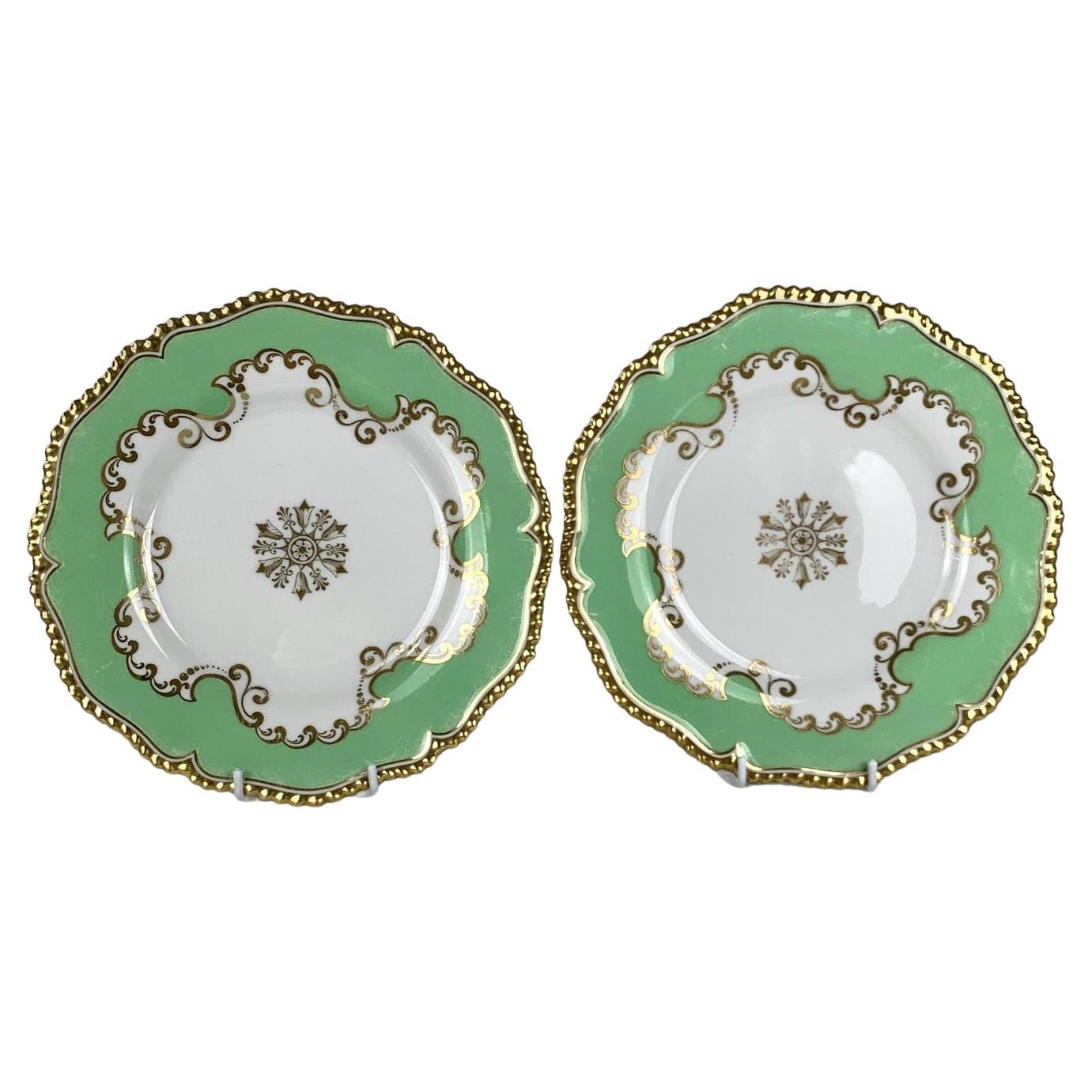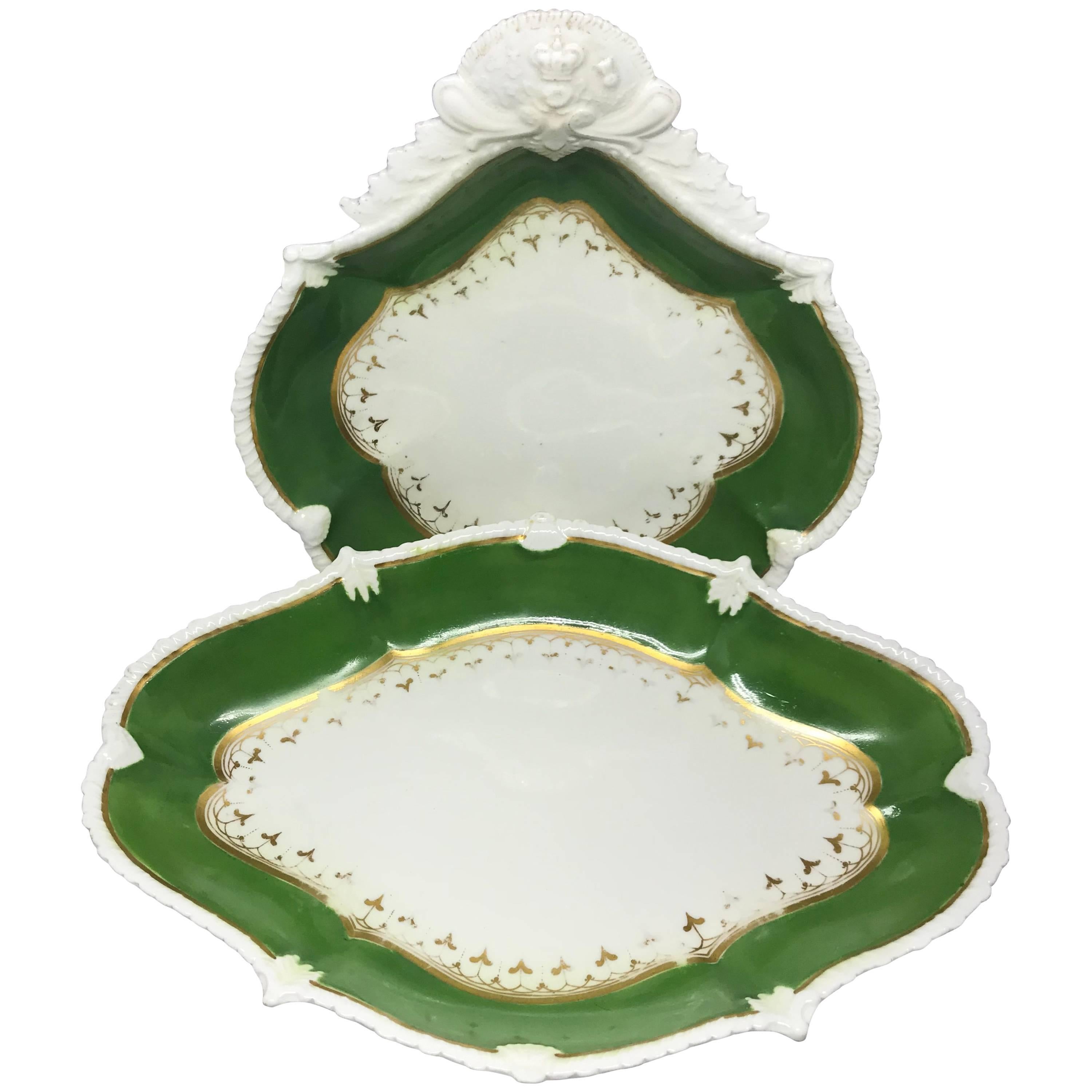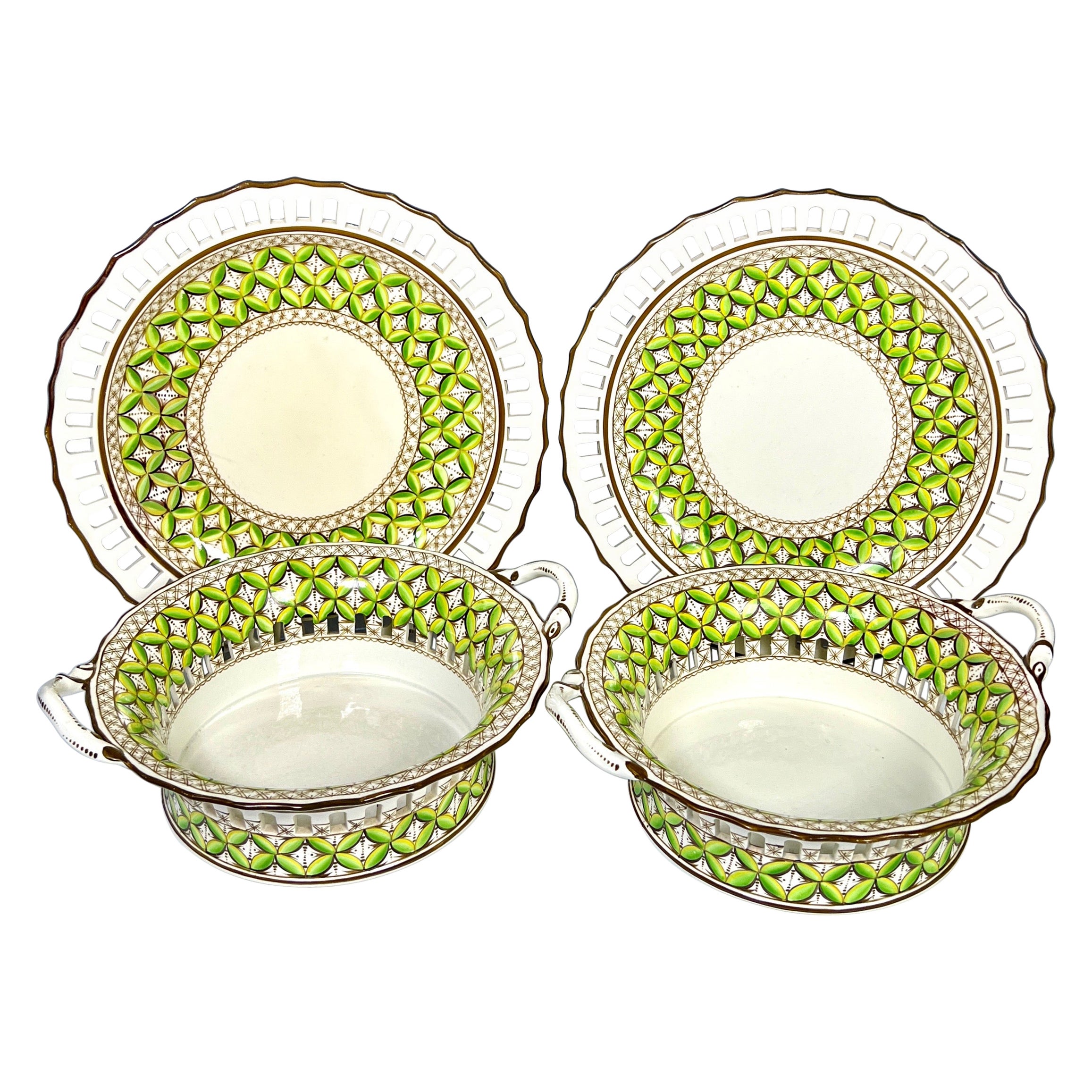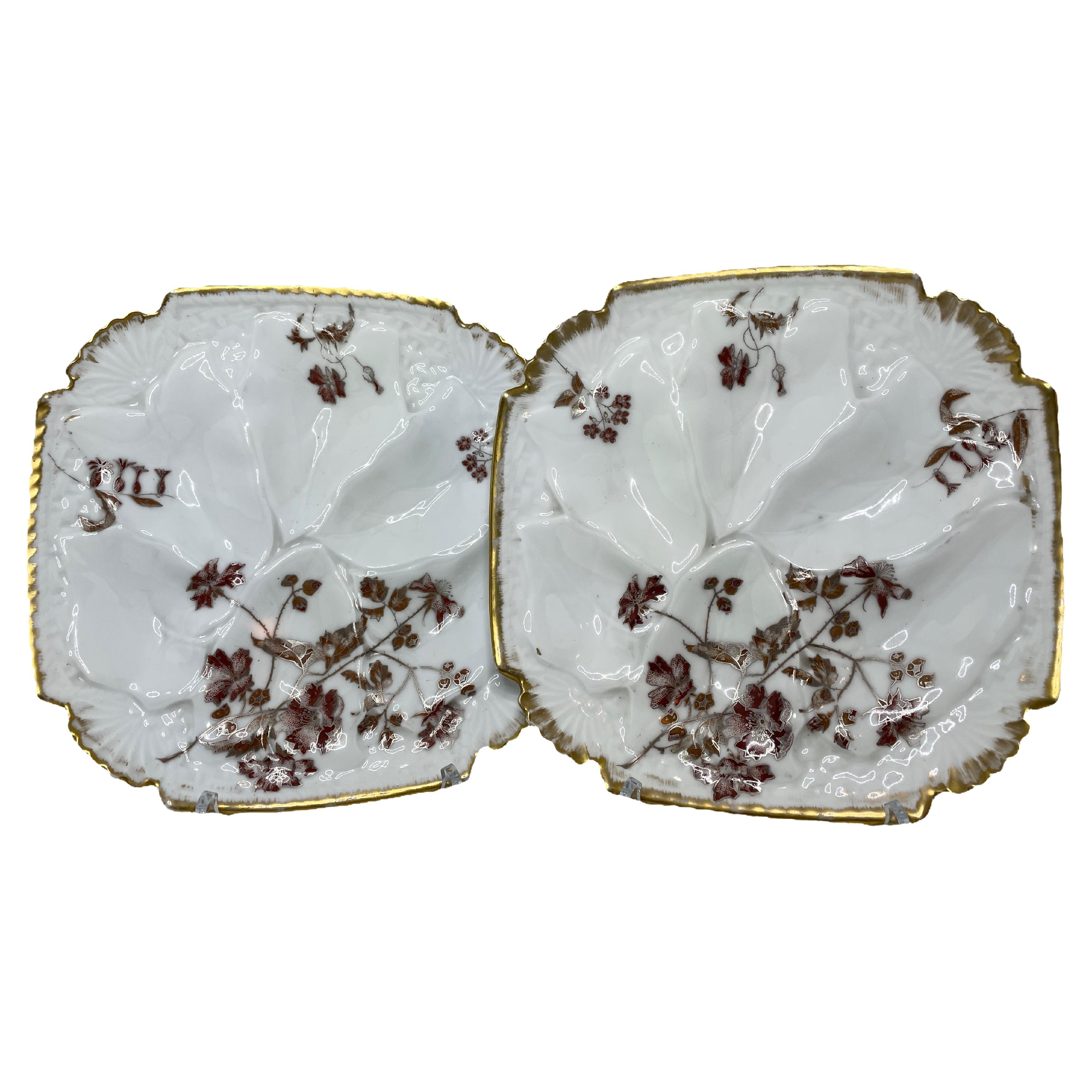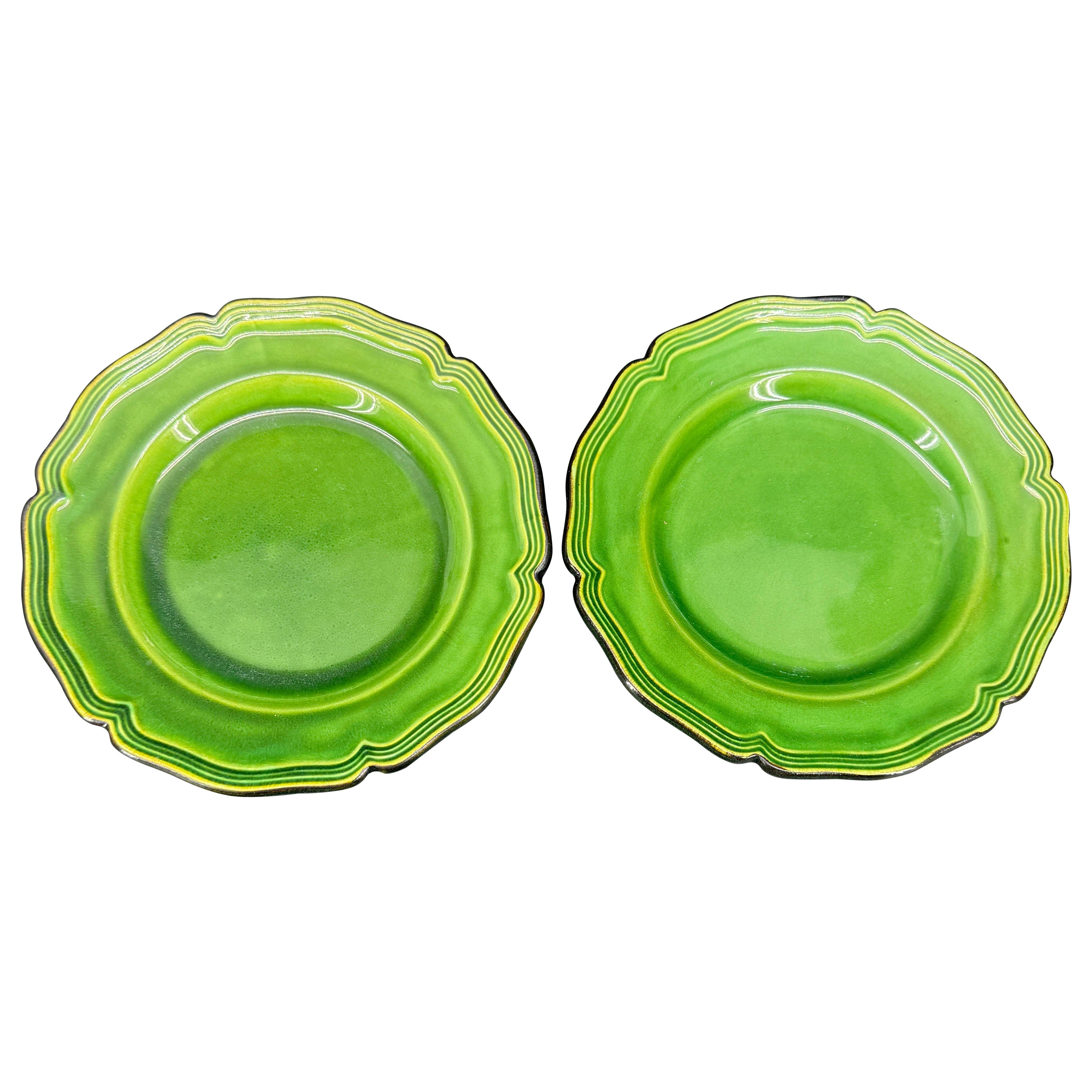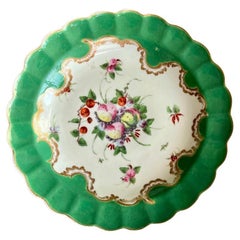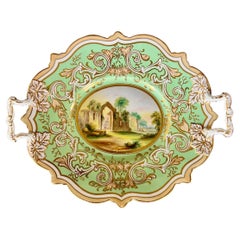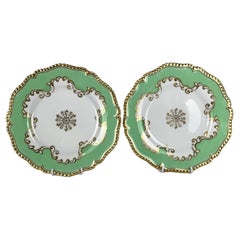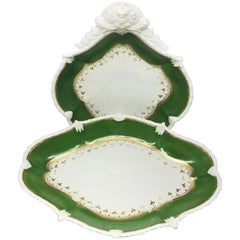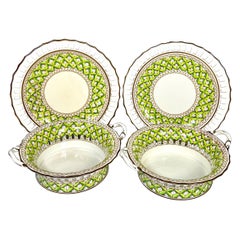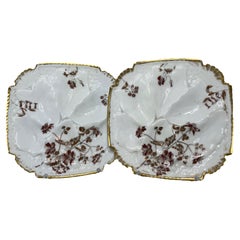Items Similar to Worcester Pair of Shell Dishes, French Green Stencil Pattern, ca 1770
Want more images or videos?
Request additional images or videos from the seller
1 of 15
Worcester Pair of Shell Dishes, French Green Stencil Pattern, ca 1770
$1,175per set
£882.97per set
€1,024.05per set
CA$1,649.53per set
A$1,830.39per set
CHF 965.49per set
MX$22,345.19per set
NOK 12,215.31per set
SEK 11,440.62per set
DKK 7,642.26per set
About the Item
This is a pair of very rare and beautiful shell dishes made by Worcester around 1770 in their 1st or "Dr Wall" period. The dishes have one scrolled handle and have a shell-like shape, hence the name shell dishes. They are decorated with a fresh "French green" (teal) dentil stencil pattern and a stylised flower with gilt foliage in the centre.
Simon Spero and John Sandon write on page 208 in their book "Worcester Porcelain 1751-1790 - The Zorensky Collection", accompanied by plate 237 with a similar plate: "This design in so-called "French Green" may have been inspired by stencilled decoration which occurs on some Continental faience." When you look carefully at the surface of the enamel decoration, it certainly seems like it was applied with a stencil rather than a brush.
Shell dishes like these formed part of large dessert services and were used for fruits or trifle; their handle lends them well to being passed around the table. Each dessert service would have 2 or 4 of these dishes.
The Worcester Porcelain Company was one of the first potteries in Britain to produce porcelain. Alongside other great potteries such as Derby, Chelsea and Bow, they pioneered a new industry that would grow out to be huge in the following century. This plate is from the first period, which is often called the "Dr Wall" period after its founder. In later years Worcester went through many different ownerships and styles, and ultimately it became the Royal Worcester factory that only finished operation in the early 21st Century.
This beautiful plate has been potted in Worcester's famous early porcelain, which is rather warm to the touch as it contained a quantity of soap rock. The plate is gently lobed and decorated with a blue scale ground. You can clearly see why this is called "blue scale"; it consists of a pattern that looks like fish scales. This is to hide the fact that at the time they were not able yet to create a smooth blue ground; this way the fact that the blue colour, applied under the glaze, was runny (or "flow blue") is nicely taken advantage of. The reserves, which have beautiful gilt scroll borders, have been painted very finely with an abundance of flowers.
The plate is marked on the underside with the underglaze blue square fret mark that Worcester used at the time, and which is an imitation of Chinese marks.
CONDITION REPORT The dishes are in perfect antique condition without any damage, repairs or crazing, and only very minimal wear, as visible in the pictures.
Antique British porcelain is never perfect. Kilns were fired on coal, and this meant that china from that period can have some firing specks from flying particles. British makers were also known for their experimentation, and sometimes this resulted in technically imperfect results. Due to the shrinkage in the kiln, items can have small firing lines or develop crazing over time, which should not be seen as damage but as an imperfection of the maker's recipes, probably unknown at the time of making. Items have often been used for many years and can have normal signs of wear, and gilt can have signs of slight disintegration even if never handled. I will reflect any damage, repairs, obvious stress marks, crazing or heavy wear in the item description but some minor scratches, nicks, stains and gilt disintegration can be normal for vintage items and need to be taken into account.
There is widespread confusion on the internet about the difference between chips and nicks, or hairlines and cracks. I will reflect any damage as truthfully as I can, i.e. a nick is a tiny bit of damage smaller than 1mm and a chip is something you can easily see with the eye; a glazing line is a break in the glazing only; hairline is extremely tight and/or superficial and not picked up by the finger; and a crack is obvious both to the eye and the finger. Etcetera - I try to be as accurate as I can and please feel free to ask questions or request more detailed pictures!
DIMENSIONS 19.5cm (7.75") diameter
- Creator:1st Period Worcester Dr. Wall (Maker)
- Dimensions:Height: 7.75 in (19.69 cm)Diameter: 7.75 in (19.69 cm)
- Sold As:Set of 2
- Style:Georgian (Of the Period)
- Materials and Techniques:
- Place of Origin:
- Period:1770-1779
- Date of Manufacture:ca 1770
- Condition:Wear consistent with age and use. In perfect antique condition.
- Seller Location:London, GB
- Reference Number:Seller: HP-WOR031stDibs: LU4805140716982
About the Seller
5.0
Vetted Professional Seller
Every seller passes strict standards for authenticity and reliability
Established in 2016
1stDibs seller since 2019
226 sales on 1stDibs
Typical response time: 2 hours
- ShippingRetrieving quote...Shipping from: London, United Kingdom
- Return Policy
Authenticity Guarantee
In the unlikely event there’s an issue with an item’s authenticity, contact us within 1 year for a full refund. DetailsMoney-Back Guarantee
If your item is not as described, is damaged in transit, or does not arrive, contact us within 7 days for a full refund. Details24-Hour Cancellation
You have a 24-hour grace period in which to reconsider your purchase, with no questions asked.Vetted Professional Sellers
Our world-class sellers must adhere to strict standards for service and quality, maintaining the integrity of our listings.Price-Match Guarantee
If you find that a seller listed the same item for a lower price elsewhere, we’ll match it.Trusted Global Delivery
Our best-in-class carrier network provides specialized shipping options worldwide, including custom delivery.More From This Seller
View AllWorcester Small Lobed Dish, Apple Green, Spotted Fruit James Giles, ca 1770
By 1st Period Worcester Dr. Wall, James Giles
Located in London, GB
This is a beautiful small deep plate made by Worcester in about 1770 in their First or the "Dr Wall" period. It is a small, lobed dish with a deep green ground, elegant tooled gildin...
Category
Antique 1770s English George III Porcelain
Materials
Porcelain
Samuel Alcock Low Oval Comport Dish, Sage Green with Landscape, ca 1850
By Samuel Alcock & Co.
Located in London, GB
An oval low-footed comport with two handles and an octagonally scrolled shape, a moulded surface with pale yellow and white scrolling foliage on a sage green ground, and a stunning l...
Category
Antique 1850s English Victorian Serving Bowls
Materials
Porcelain
Derby Lobed Dish, Camden Service, William Billingsley Roses on Green, 1795 (1)
By Derby
Located in London, GB
This is a very rare oval lobed dish from the famous "Earl of Camden" service made by the Derby Porcelain Company in 1795. The service was painted with typical English roses by William Billingsley, one of Britain's most famous painters, and responsible for exactly this type of rose painting on British porcelain.
There are more items available in this pattern, see separate listings. To keep these items together we'd be happy to offer a discount on multiple purchases - please ask!
The Derby Porcelain Company, later called Royal Crown Derby, is currently the oldest British porcelain factory still in production. The Derby pottery was one of the most prominent potteries right from the start of English porcelain production in the mid 1700s to today, and the factory went through many iterations. In the 1820s, it was called "Bloor Derby" as it came under the ownership of Robert Bloor; this factory later closed but its legacy was continued under the ownership of a group of employees, and later this was merged into a new factory called Royal Crown Derby, which is still in operation today and still carries forward some of the oldest patterns that have made it famous over the centuries.
William Billingsley was a brilliant but notoriously difficult man who left behind a trail of debts, broken hearts and mystery - but he was also one of the most important people in the history British porcelain. Billingsley revolutionised the way British decorators painted flowers; he added a freedom and artistry that now singles out British flower painting, and he created a new technique for painting roses, which you can see in this design. Billingsley worked at Derby, Worcester and Mansfield. He also set up his own potteries in Pinxton and Nantgarw and created some of the best porcelain ever made, but racking up great debts, before running off in the dead of night and ending his days at Coalport painting flowers.
Items painted by William Billingsley are rare and very much in demand - together with Thomas Baxter's work they are probably among the most desired pieces of British porcelain.
The Earl of Camden service was a huge service ordered by Lady Camden in 1795. It had to be produced under great, and unrealistic, time pressure and was notoriously late, much to Lady Camden's chagrin. She wanted the service to be produced by only the best artisans and therefore William Billingsley was tasked with painting all items - but it is thought that when it was clear the deadline was impossible to make, he enlisted the help of John Brewer for some of the last items, such as the ice pails. This plate shows the typical "Billingsley" roses: a beautiful naturally flowing garland of English roses interspersed with buds, trailing around a crisp gilt ribbon. The way the roses link into each other, the way each individual one is completely different, the light effects achieved by rubbing out some of the pink paint, and the very fine buds and foliage all point to these being from Billingsley's hand.
This dish came together with a plate that bears labels that point to a rich provenance: the Doris Wheatley Collection, the Daniel Collection, Derek Gardner...
Category
Antique 1790s English George III Serving Bowls
Materials
Porcelain
Derby Oval Dish, Camden Service, William Billingsley Roses on Green, 1795 (2)
By Derby
Located in London, GB
This is a very rare oval lobed dish from the famous "Earl of Camden" service made by the Derby Porcelain Company in 1795. The service was painted with typical English roses by William Billingsley, one of Britain's most famous painters, and responsible for exactly this type of rose painting on British porcelain.
There are more items available in this pattern, see separate listings. To keep these items together we'd be happy to offer a discount on multiple purchases - please ask!
The Derby Porcelain Company, later called Royal Crown Derby, is currently the oldest British porcelain factory still in production. The Derby pottery was one of the most prominent potteries right from the start of English porcelain production in the mid 1700s to today, and the factory went through many iterations. In the 1820s, it was called "Bloor Derby" as it came under the ownership of Robert Bloor; this factory later closed but its legacy was continued under the ownership of a group of employees, and later this was merged into a new factory called Royal Crown Derby, which is still in operation today and still carries forward some of the oldest patterns that have made it famous over the centuries.
William Billingsley was a brilliant but notoriously difficult man who left behind a trail of debts, broken hearts and mystery - but he was also one of the most important people in the history British porcelain. Billingsley revolutionised the way British decorators painted flowers; he added a freedom and artistry that now singles out British flower painting, and he created a new technique for painting roses, which you can see in this design. Billingsley worked at Derby, Worcester and Mansfield. He also set up his own potteries in Pinxton and Nantgarw and created some of the best porcelain ever made, but racking up great debts, before running off in the dead of night and ending his days at Coalport painting flowers.
Items painted by William Billingsley are rare and very much in demand - together with Thomas Baxter's work they are probably among the most desired pieces of British porcelain.
The Earl of Camden service was a huge service ordered by Lady Camden in 1795. It had to be produced under great, and unrealistic, time pressure and was notoriously late, much to Lady Camden's chagrin. She wanted the service to be produced by only the best artisans and therefore William Billingsley was tasked with painting all items - but it is thought that when it was clear the deadline was impossible to make, he enlisted the help of John Brewer for some of the last items, such as the ice pails. This plate shows the typical "Billingsley" roses: a beautiful naturally flowing garland of English roses interspersed with buds, trailing around a crisp gilt ribbon. The way the roses link into each other, the way each individual one is completely different, the light effects achieved by rubbing out some of the pink paint, and the very fine buds and foliage all point to these being from Billingsley's hand.
This dish came together with a plate that bears labels that point to a rich provenance: the Doris Wheatley Collection, the Daniel Collection, Derek Gardner...
Category
Antique 1790s English George III Serving Bowls
Materials
Porcelain
Samuel Alcock Pair of Low Comports, Grey, Gilt with Landscapes, Flowers, ca 1859
By Samuel Alcock & Co.
Located in London, GB
This is a rather stunning pair of one-handled low comports with pierced rims, a warm grey ground with elaborate gilt foliage, three very fine flower reserves each, and a large mounta...
Category
Antique 1850s English Rococo Revival Porcelain
Materials
Porcelain
$990 / set
Free Shipping
Spode Creamware Dessert Service, Avocado Green, Chinoiserie, Regency, 1814
By Spode
Located in London, GB
This is a beautiful Spode creamware dessert service made in 1814, which was the Regency era. The service is decorated in a printed and hand-colored Chi...
Category
Antique 1810s English Regency Porcelain
Materials
Creamware
You May Also Like
Pair Antique Flight Barr Barr Worcester Porcelain Plates Apple Green & Gold 1825
By Barr, Flight & Barr Worcester
Located in Katonah, NY
This pair of Flight, Barr, Barr Worcester porcelain plates was hand-painted at the Worcester factory, in England, circa 1825.
They feature a vibrant apple green complemented by lavis...
Category
Antique Early 19th Century English Neoclassical Decorative Dishes and Vi...
Materials
Porcelain
Set of English Green and Gilt Banded Serving Dishes
Located in New York, NY
Set of English green and gilt banded serving dishes Scallop edged oval dish and shell form shaped sweetmeat dish with Scottish crowned thistle; both with gilt border.
Dimensions: Ov...
Category
Antique 19th Century English Serving Bowls
Materials
Porcelain
Pair of Spode 19th C Pierced Green Chestnut Baskets & Under Plates
By Spode
Located in Great Barrington, MA
This pair of rare 19th c Spode Chestnut bowls are in amazing original condition and feature a green enamel leaf motif with pierced border. Each has two handles and basketweave on bot...
Category
Antique 1850s English Regency Revival Porcelain
Materials
Porcelain
Set of Two Limoges France Oyster Plate French Vintage Porcelain
By Limoges
Located in Nuernberg, DE
A set of 2 vintage French oyster plates. Each oyster plate features 6 wells for oysters. They are marked at the back. Nice addition to you...
Category
Early 20th Century French Porcelain
Materials
Porcelain
Pair of French Poterie Milon S Dieulefit Green Glazed Plates
By Poterie Milon S
Located in Haddonfield, NJ
These Dieulefit plates from are a beautiful example of traditional French pottery. Slightly scalloped edges add a touch of refined elegance and the cheery, iconic green glaze makes f...
Category
20th Century French French Provincial Serving Pieces
Materials
Faience
Herend Hungary Porcelain "Chinese Bouquet Apponyi Green" Wall Decoration Plates
By Herend
Located in Delft, NL
Herend Hungary Porcelain "Chinese Bouquet Apponyi Green" Wall Decoration Plates
Herend Hungary porcelain plates for as decoration to hang on the wall, with openwork edges
Beautiful...
Category
20th Century Hungarian Porcelain
Materials
Porcelain
More Ways To Browse
Antique Silver Brush
Antique Flow Blue
Green Dishes Antique
Stenciled Table
Chinese Wall Scrolls
Antique Dishes From England
Chelsea Plate
Chinese Fish Porcelain
The Continental Furniture Company
Flying Fish
Antique Teal Paint
Blue John Table
Flow Blue Porcelain
First Period Worcester
Antique Royal Worcester Plates
French Faience Nevers
Royal Worcester China
Pair Royal Worcester
